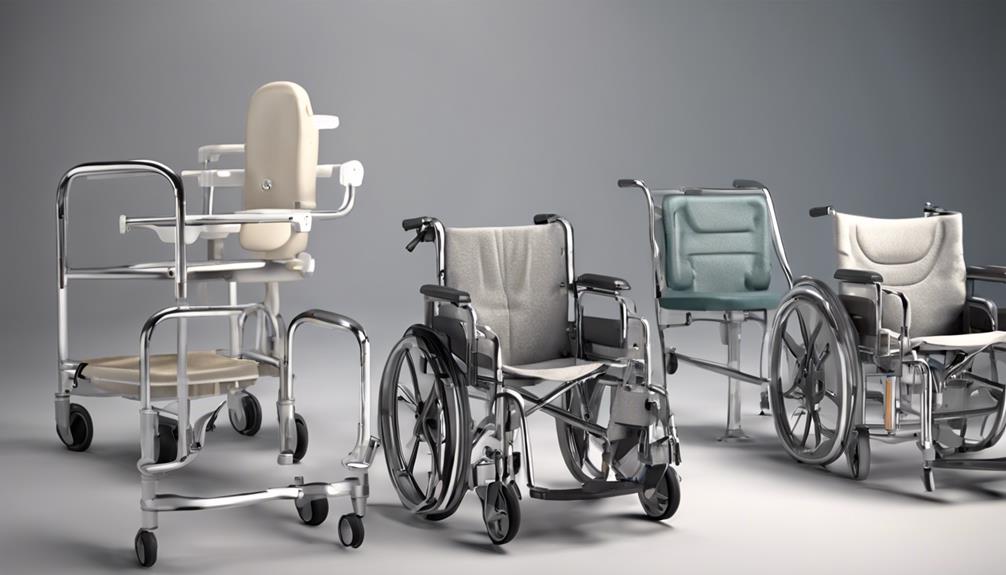Durable Medical Equipment (DME) Coverage: Balancing Quality and Cost
When considering the balance between quality and cost in Durable Medical Equipment (DME) coverage, you might question whether it's possible to maintain both without compromising one over the other. However, by exploring innovative approaches to procurement and utilization, you can discover ways to optimize patient care while managing expenses efficiently. As we explore the intricate interplay between quality standards and financial considerations in DME coverage, a nuanced understanding of this dynamic landscape becomes essential for healthcare providers seeking to deliver exceptional care within budget constraints.
Key Takeaways
- Prioritize durable equipment for quality care within budget constraints.
- Implement cost-effective strategies without compromising patient outcomes.
- Select equipment based on patient needs to enhance satisfaction and management.
- Navigate insurance complexities to ensure proper reimbursement for DME.
- Balance quality and cost to provide adequate DME coverage for better patient outcomes.
Importance of DME Coverage
Understanding the importance of DME coverage in healthcare requires a thorough evaluation of its impact on patient outcomes and overall healthcare costs. Durable Medical Equipment (DME) plays a vital role in enhancing patient outcomes by providing necessary support and assistance for individuals with various medical conditions. Access to DME can greatly improve the quality of life for patients, facilitating mobility, independence, and overall well-being.
Moreover, DME coverage also has substantial financial implications. While the initial cost of acquiring durable medical equipment may seem substantial, studies have shown that investing in DME can lead to long-term cost savings for the healthcare system. By preventing hospital readmissions, reducing complications, and promoting faster recovery, DME helps in lowering healthcare expenditures associated with prolonged hospital stays and unnecessary medical interventions.
Factors Influencing Equipment Quality
To guarantee ideal patient outcomes and cost-effectiveness in healthcare, examining the factors that influence the quality of durable medical equipment (DME) is essential. Equipment durability is a vital aspect that directly impacts quality. DME that's built to last not only safeguards patient safety but also reduces the need for frequent replacements, leading to cost-effective solutions in the long run.
Additionally, the reliability of the equipment plays a significant role in its quality. Reliable DME minimizes the risk of malfunctions or breakdowns, promoting uninterrupted patient care.
Moreover, the materials used in manufacturing DME influence its quality. High-quality materials contribute to the durability and performance of the equipment, ultimately affecting patient outcomes.
Ergonomics and user-friendliness are essential factors as well. DME that's easy to use and comfortable for both patients and healthcare providers enhances overall quality of care delivery. By considering these factors and prioritizing equipment durability and cost-effective solutions, healthcare facilities can ensure they're providing high-quality DME that meets both patient needs and budget constraints.
Strategies for Cost Containment
To effectively manage costs in DME coverage, consider incorporating budget-friendly options and implementing efficient utilization practices.
By exploring cost-effective alternatives without compromising quality, you can strike a balance between financial constraints and patient care needs.
Embracing strategies that prioritize both affordability and efficacy guarantees sustainable and responsible resource allocation in healthcare settings.
Budget-Friendly DME Options
Exploring cost-effective options for durable medical equipment (DME) can have a substantial impact on overall healthcare expenditure without compromising quality. By considering affordable solutions and cost-effective alternatives, healthcare providers can effectively manage costs while ensuring patients receive the necessary DME. Here are some budget-friendly options to help you strike the right balance between quality and cost:
| DME Option | Description | Cost Savings |
|---|---|---|
| Refurbished Equipment | Pre-owned equipment that is restored to a like-new condition, often available at a fraction of the cost of new equipment. | Up to 50% savings. |
| Rental Programs | Renting equipment for short-term needs can be more cost-effective than purchasing outright, especially for items needed temporarily. | Significant savings on upfront costs. |
| Group Purchasing | Collaborating with other healthcare facilities to buy DME in bulk can lead to volume discounts and lower per-unit costs. | Potential for substantial savings. |
Efficient Utilization Practices
Efficiently implementing utilization practices is paramount for achieving cost containment in durable medical equipment (DME) management. To guarantee cost-effective solutions, strategic resource allocation is essential. By analyzing utilization patterns and trends, you can identify opportunities to optimize equipment usage, prevent unnecessary acquisitions, and reduce overall expenses. Implementing protocols for proper equipment maintenance and monitoring can extend the lifespan of DME, mitigating the need for frequent replacements and repairs. Additionally, establishing clear guidelines for evaluating patient needs and prescribing equipment based on evidence-based criteria can prevent the misuse or overuse of resources.
Utilizing data analytics to track equipment utilization rates and outcomes can inform decision-making processes, enabling you to reallocate resources effectively. By leveraging technology such as inventory management systems and utilization tracking software, healthcare facilities can streamline workflows, reduce waste, and enhance operational efficiency. Collaborating with healthcare providers, payers, and suppliers to standardize utilization protocols and negotiate favorable pricing agreements can further optimize resource allocation and drive cost savings. Through a proactive approach to efficient utilization practices, organizations can strike a balance between maintaining quality care and managing costs in the domain of DME.
Patient-Centered Equipment Selection
Selecting medical equipment with the patient's needs in mind promotes excellent outcomes and enhances overall satisfaction with care. Customized solutions tailored to individual patient requirements play a pivotal role in improving patient satisfaction levels. When patients receive medical equipment that aligns with their specific needs and preferences, they're more likely to experience better health outcomes and increased comfort, leading to higher overall satisfaction with their care.
Research indicates that patient-centered equipment selection results in improved compliance with treatment plans and better management of medical conditions. Patients are more likely to actively engage in their care when they feel that the equipment meets their unique requirements, ultimately leading to enhanced treatment effectiveness.
Insurance Reimbursement Challenges
Considering the complexities of insurance reimbursement in the healthcare industry, understanding the nuances of coverage criteria is crucial for providers seeking excellent financial outcomes. Reimbursement obstacles often arise due to the intricacies of insurance complexities. Providers must navigate a landscape filled with prior authorization requirements, coverage limitations, and varying reimbursement rates. These challenges can lead to delays in payments, increased administrative burden, and potential revenue loss.
Insurance complexities can greatly impact the reimbursement process for durable medical equipment (DME). Providers must make sure that the equipment prescribed meets the specific criteria outlined by insurance companies to avoid claim denials or payment delays. Understanding these criteria and staying updated on policy changes is essential for optimizing reimbursement and maintaining financial stability.
To overcome reimbursement challenges, providers should invest in robust billing and coding systems, conduct regular training for staff members, and establish strong communication channels with payers. By proactively addressing reimbursement obstacles and staying informed about insurance complexities, providers can streamline the reimbursement process and enhance financial performance.
Technology Advancements in DME
The integration of cutting-edge technology has revolutionized the landscape of durable medical equipment (DME), enhancing both patient care and operational efficiency. With advancements in remote monitoring and wearable technology, DME is becoming more sophisticated and user-friendly. Here are five ways technology is shaping the future of DME:
- Remote Monitoring: Real-time data collection allows healthcare providers to track patient progress and intervene promptly when needed.
- Wearable Technology: Devices like smartwatches and activity trackers can now monitor essential signs and activity levels, providing valuable insights for personalized care.
- Smart Sensors: Embedded sensors in DME devices can detect changes in patient behavior, alerting caregivers to potential issues early on.
- Telehealth Integration: Seamless connectivity between DME and telehealth platforms enables remote consultations and adjustments to treatment plans.
- Data Analytics: Analyzing the vast amount of data collected from DME devices can lead to predictive insights, enhancing proactive healthcare management strategies.
These technological advancements not only improve patient outcomes but also streamline healthcare delivery processes.
Regulatory Impact on Coverage
When considering the regulatory impact on coverage for durable medical equipment (DME), it's essential to assess both regulatory compliance considerations and coverage limitations.
Understanding the intricate web of regulations can provide insights into how coverage is determined and what limitations may exist.
Regulatory Compliance Considerations
To guarantee extensive DME coverage, understanding and adhering to regulatory compliance considerations is essential for balancing quality and cost effectively. Dealing with compliance challenges and staying up-to-date with policy updates are critical to guarantee seamless reimbursement processes and patient access to necessary DME.
Here are some key regulatory compliance considerations to keep in mind:
- Documentation Requirements: Detailed and accurate documentation is essential to meet compliance standards and justify the medical necessity of DME.
- Billing and Coding Guidelines: Adhering to specific billing and coding guidelines is essential to prevent claim denials and ensure proper reimbursement.
- Supplier Accreditation: Ensuring that DME suppliers are accredited by relevant organizations is necessary to maintain compliance and quality standards.
- Patient Privacy Regulations: Safeguarding patient health information in compliance with HIPAA regulations is paramount for maintaining data security.
- Anti-Fraud Measures: Implementing anti-fraud measures and monitoring practices can help prevent fraudulent activities and maintain compliance integrity.
Coverage Limitations Analysis
Exploring the landscape of coverage limitations involves a thorough examination of regulatory impacts on DME access and reimbursement processes. Reimbursement rates play a pivotal role in determining the extent of coverage gaps for patients in need of durable medical equipment (DME). When reimbursement rates are insufficient, it can lead to restricted access and financial burdens for both patients and providers.
Utilization management strategies implemented by payers also contribute to coverage limitations by imposing restrictions on the frequency or duration of DME usage. While these strategies aim to control costs, they can inadvertently hinder patient outcomes by impeding access to necessary equipment.
Analyzing coverage limitations through the lens of regulatory impact is essential in understanding how barriers to reimbursement and utilization management practices influence the quality of care received by patients requiring DME. By addressing these challenges, stakeholders can work towards a more balanced approach that guarantees adequate coverage without compromising patient outcomes.
Conclusion
In the complex world of healthcare, balancing quality and cost in Durable Medical Equipment coverage is like walking a tightrope.
By carefully selecting high-quality equipment, implementing cost containment strategies, and staying informed about technological advancements, healthcare providers can successfully navigate this delicate balance.
Remember, just as a skilled tightrope walker maintains equilibrium with precision and grace, so too can healthcare professionals achieve peak patient care within budget constraints by prioritizing quality and cost-effectiveness in DME coverage.







